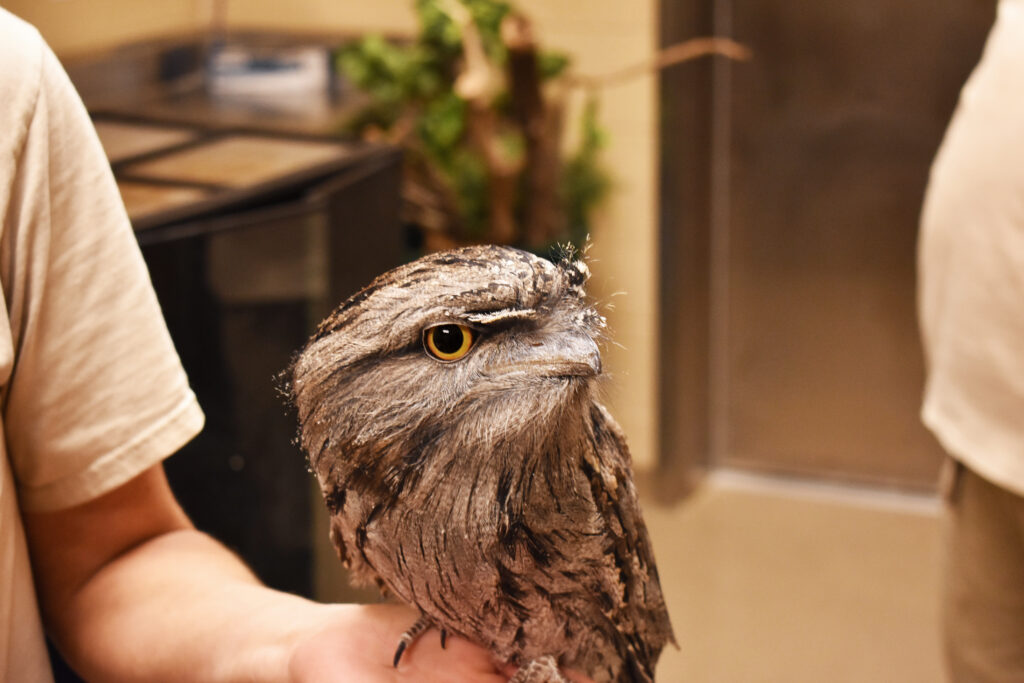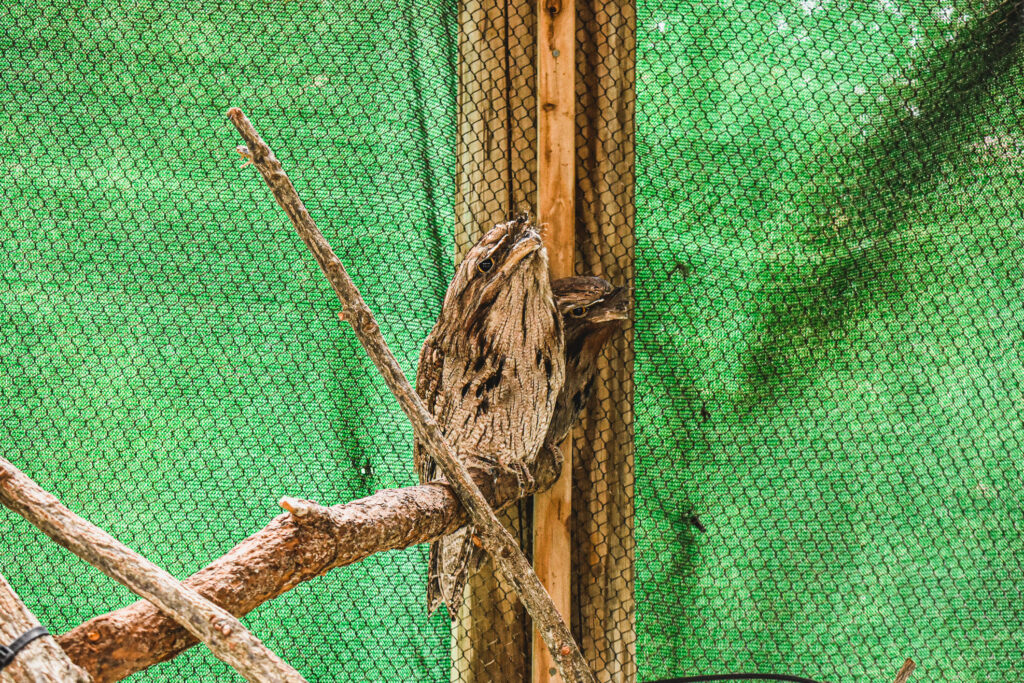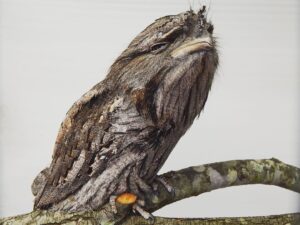We’re Stumped on a Title for this Blog
Just kidding, we knew exactly what we wanted to call this month’s Tales of the Tails blog, featuring one of our coolest bird species, but we also wanted to use a pun that we’ll explain in just a bit. Meet the Tawny Frogmouth. Let’s start off by saying this bird species is not a member of the owl family; let ‘s repeat – not an owl!

Tawny frogmouths, also not frogs, are members of the nightjar family of birds. Nightjars are identified by their medium body size with long wings, short legs and stout bills. There are fourteen known species of frogmouths, which have owl-like eyes and a beak that is sharply hooked, triangular in shape and wide like the mouth of a frog. All of these features combined help give the tawny frogmouth species its name. They are also a very expressive species and are known for making various facial expressions and vocalizations.
Tawny frogmouths are usually between eight to 21 inches in height and weigh up to one-and-a-half pounds. They have bright yellow eyes, are brownish-gray in color and covered in black spots and streaks. Their coloring helps to camouflage in the trees, where they exhibit a unique behavior called stumping! During “stumping”, the bird will stiffen its body, stay very still and simulate a tree branch. Did we stump you with this pun?
Tawny frogmouths are native to forests, scrublands and woodlands in Australia and Tasmania. They are nocturnal, sleeping while camouflaged in a tree low to the ground by day, and hunting at night using a sit-and-wait-and pounce technique. Their diet primarily consists of insects such as spiders, worms, slugs, snails, centipedes and cockroaches. They are also opportunistic eaters and will occasionally prey on small mammals, reptiles, frogs and other types of birds.
Although tawny frogmouths are listed as a species of least concern, they do face threats that are primarily caused by humans. They are often accidentally hit by cars or are unintentionally poisoned by pesticides.
At the Virginia Zoo, there are three tawny frogmouths – a pair in the Asia Aviary and one who lives behind-the-scenes at the Program Animal Building.

Blending in very well with their exhibit surroundings in the Asia Aviary are Barnaby and Robin. Barnaby is almost eight years old and will celebrate his birthday on May 1. He was born at Sea World Orlando, which is where he lived prior to arriving at the Virginia Zoo in February 2020. Barnaby is often suspicious of new people and likes to yell at Keepers when they enter the exhibit, but he also very much likes when Keepers hand feed him worms from a pair of tongs. He will also watch the crickets that don’t make it into his mouth hop away!
Robin is Barnaby’s mate, and was matched to breed with him as part of the Species Survival Plan. She is about half the size of Barnaby and spends a majority of her time either snuggling up to him or stumping. Robin also likes to be fed with tongs by Keepers but will catch any bugs that try to escape her beak. Robin was born on October 3, 2012 at the Adelaide Zoo in Australia, and lived at the St. Louis Zoo and Sea World Orlando before making the move with Barnaby to the Virginia Zoo.
 The third tawny frogmouth found at the Zoo is named Chili, and you may recognize her from our educational programs. Chili is the Zoo’s ambassador for her species and lives behind-the-scenes. She recently celebrated her third birthday on April 3 and lived at the Brevard Zoo prior to coming to Virginia in 2018. Keepers say I don’t seem to be fond of any particular enrichment items, and they are driven bonkers trying to find something she likes! Chili is excellent at practicing her grumpy look and prefers to only eat if she is being hand fed. Chili, and her siblings that live at other zoos, were all named after soups!
The third tawny frogmouth found at the Zoo is named Chili, and you may recognize her from our educational programs. Chili is the Zoo’s ambassador for her species and lives behind-the-scenes. She recently celebrated her third birthday on April 3 and lived at the Brevard Zoo prior to coming to Virginia in 2018. Keepers say I don’t seem to be fond of any particular enrichment items, and they are driven bonkers trying to find something she likes! Chili is excellent at practicing her grumpy look and prefers to only eat if she is being hand fed. Chili, and her siblings that live at other zoos, were all named after soups!
Be sure to reserve your tickets online to visit the Zoo or book an education program to see our tawny frogmouths!